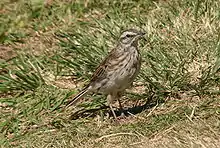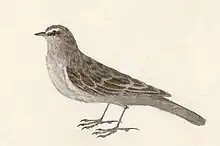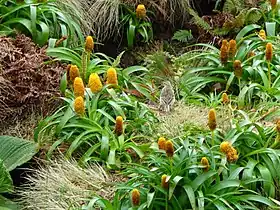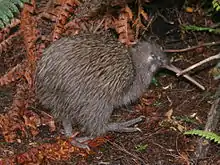New Zealand pipit
The New Zealand pipit (Anthus novaeseelandiae) is a fairly small passerine bird of open country in New Zealand and outlying islands. It belongs to the pipit genus Anthus in the family Motacillidae.
| New Zealand pipit | |
|---|---|
 | |
| On Kapiti Island | |
| Scientific classification | |
| Domain: | Eukaryota |
| Kingdom: | Animalia |
| Phylum: | Chordata |
| Clade: | Dinosauria |
| Class: | Aves |
| Order: | Passeriformes |
| Family: | Motacillidae |
| Genus: | Anthus |
| Species: | A. novaeseelandiae |
| Binomial name | |
| Anthus novaeseelandiae (Gmelin, JF, 1789) | |
It was formerly lumped together with the Richard's, African, Mountain and Paddyfield pipits in a single species: Richard's pipit, Anthus novaeseelandiae. Many authors split the Australasian pipit further into two species: Australian pipit (Anthus australis) in Australia[2] and New Guinea and New Zealand pipit (Anthus novaeseelandiae), also called pihoihoi, in New Zealand.
Taxonomy

The New Zealand pipit was formally described in 1789 by the German naturalist Johann Friedrich Gmelin in his revised and expanded edition of Carl Linnaeus's Systema Naturae. He placed it with the larks in the genus Alauda and coined the binomial name Alauda novaeseelandiae.[3] Gmelin based his account on the "New Zealand lark" that had been described and illustrated in 1783 by the English ornithologist John Latham in his multi-volume work A General Synopsis of Birds.[4] The naturalist Joseph Banks had provided Latham with a painting of the bird by Georg Forster who had accompanied James Cook on his second voyage to the Pacific Ocean. Forster's picture was drawn from a specimen collected at Queen Charlotte Sound, a fiord on the northwest corner of New Zealand's South Island. The picture is the holotype for the species and is now held by the Natural History Museum in London.[5][6] The New Zealand pipit in now one of more than 40 pipits placed in the genus Anthus that was introduced in 1805 by the German naturalist Johann Matthäus Bechstein.[7]
Four subspecies are recognised:[7]
- A. n. novaeseelandiae (Gmelin, JF, 1789) – North, South and Stewart Island and satellites (New Zealand)
- A. n. chathamensis Lorenz von Liburnau, L, 1902 – Chatham Islands (east of South Island, New Zealand)
- A. n. aucklandicus Gray, GR, 1862 – Auckland and Campbell Islands (south of South Island, New Zealand)
- A. n. steindachneri Reischek, 1889 – Antipodes Islands (southeast of Stewart Island, New Zealand)
Description
It is a slender bird, 16 to 19 cm long, and weighs about 40 grams. The plumage is pale brown above with dark streaks. The underparts are pale with streaks on the breast. There is a pale stripe over the eye and dark malar and moustachial stripes. The long tail has white outer-feathers and is often wagged up and down. The legs are long and pinkish-brown while the bill is slender and brownish.
Ecology
It is a bird of open habitats such as grassland, farmland, roadsides, dry river beds, sand dunes and open woodland. It forages on the ground for small invertebrates such as beetles, spiders and insect larvae. It will also eat seeds such as those of grasses.
The birds' numbers have declined in parts of New Zealand due to the improvement of pastures, use of pesticides and predation by introduced species.
Gallery
.jpg.webp) New Zealand pipit
New Zealand pipit A New Zealand pipit A. n. aucklandicus and megaherbs on Campbell Island
A New Zealand pipit A. n. aucklandicus and megaherbs on Campbell Island_(cropped).jpg.webp) Anthus novaeseelandiae egg in the collection of Auckland Museum
Anthus novaeseelandiae egg in the collection of Auckland Museum
References
- BirdLife International (2019). "Anthus novaeseelandiae". IUCN Red List of Threatened Species. 2018: e.T22718480A131983972. Retrieved 19 November 2021.
- Menkhorst, Peter; Rogers, Danny; et al. (2017). The Australian Bird Guide. Clayton South, Victoria: CSIRO. p. 500. ISBN 9780643097544.
- Gmelin, Johann Friedrich (1789). Systema naturae per regna tria naturae : secundum classes, ordines, genera, species, cum characteribus, differentiis, synonymis, locis (in Latin). Vol. 1, Part 2 (13th ed.). Lipsiae [Leipzig]: Georg. Emanuel. Beer. p. 799.
- Latham, John (1783). A General Synopsis of Birds. Vol. 2, Part 2. London: Printed for Leigh and Sotheby. p. 384, Plate 51.
- Medway, David G. (1976). "Extant types of New Zealand birds from Cook's voyages. Part 1: Historical and type paintings" (PDF). Notornis. 23 (1): 45-60 [57, "New Zealand Pipit"].
- Lysaght, Averil (1959). "Some eighteenth century bird paintings in the library of Sir Joseph Banks (1743-1820)". Bulletin of the British Museum (Natural History), Historical Series. 1 (6): 251-371 [305, No. 143]. doi:10.5962/p.92313.
- Gill, Frank; Donsker, David; Rasmussen, Pamela, eds. (July 2023). "Waxbills, parrotfinches, munias, whydahs, Olive Warbler, accentors, pipits". IOC World Bird List Version 13.2. International Ornithologists' Union. Retrieved 23 August 2023.
- Heather, Barrie D. & Robertson, Hugh (1996) The Field Guide to the Birds of New Zealand
Further reading
- Higgins, P.J.; Peter, J.M.; Cowling, S.J., eds. (2006). "Anthus novaeseelandiae Australasian pipit" (PDF). Handbook of Australian, New Zealand & Antarctic Birds. Vol. 7, Boatbill to starlings, Part 7 B, Dunnock to starling. Melbourne, Victoria: Oxford University Press. pp. 1359–1389. ISBN 978-0-19-553996-7.

